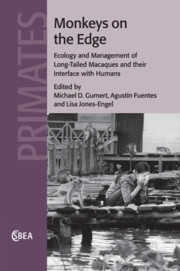Book contents
- Frontmatter
- Contents
- List of contributors
- Foreword
- Preface
- Acknowledgements
- Part I The status and distribution of long-tailed macaques
- 1 The common monkey of Southeast Asia: Long-tailed macaque populations, ethnophoresy, and their occurrence in human environments
- 2 Distribution and current status of long-tailed macaques (Macaca fascicularis aurea) in Myanmar
- 3 Distribution and present status of long-tailed macaques (Macaca fascicularis) in Laos and their ecological relationship with rhesus macaques (Macaca mulatta)
- Part II The human–macaque interface
- Part III Ethnophoresy of long-tailed macaques
- Part IV Comparisons with rhesus macaques
- Part V Understanding and managing the human–macaque interface
- Index
- References
2 - Distribution and current status of long-tailed macaques (Macaca fascicularis aurea) in Myanmar
from Part I - The status and distribution of long-tailed macaques
Published online by Cambridge University Press: 16 May 2011
- Frontmatter
- Contents
- List of contributors
- Foreword
- Preface
- Acknowledgements
- Part I The status and distribution of long-tailed macaques
- 1 The common monkey of Southeast Asia: Long-tailed macaque populations, ethnophoresy, and their occurrence in human environments
- 2 Distribution and current status of long-tailed macaques (Macaca fascicularis aurea) in Myanmar
- 3 Distribution and present status of long-tailed macaques (Macaca fascicularis) in Laos and their ecological relationship with rhesus macaques (Macaca mulatta)
- Part II The human–macaque interface
- Part III Ethnophoresy of long-tailed macaques
- Part IV Comparisons with rhesus macaques
- Part V Understanding and managing the human–macaque interface
- Index
- References
Summary
Introduction
Myanmar is situated in the west of the Indochina Peninsula and geographically ranges from 9°58' N to 28°29'N and from 92°10'E to 101°10'E, with a land area of 676,553 km2 and a coastline of 2,832 km (Bird Life International, 2005). The wide variation in topography and climate has produced a rich diversity of wildlife in Myanmar, which is a component of the Indo-Myanmar Hotspot for biodiversity (Bird Life International, 2005). New mammal species have been discovered quite recently, such as the leaf deer (Muntiacus putaoensis, Amato et al., 1999) and the Kachin woolly bat (Kerivoula kachinensis, Bates et al., 2004). Primate fauna are also rich in Myanmar (Tun Yin, 1967; FAO, 1985; Kyaw Nyunt Lwin, 1995; Parr and Tin Than, 2007), including one species of slow loris (Nycticebus coucang), five species of macaques (Macaca assamensis, M. arctoides, M. fascicularis, M. mulatta, and M. nemestrina), five species of leaf monkeys (Trachypithecus obscurus, T. phayrei, T. cristatus, T. pileatus, and Presbytis femoralis), and two species of gibbons (Hylobates hoolock and H. lar).
The long-tailed macaque in Myanmar is classified as a distinctive subspecies (Macaca fascicularis aurea), with parts of this subspecies population also occurring in Thailand and Bangladesh. For the most part, the biology and evolution of this subspecies remains unknown. Evolutionary scenarios on the origins of long-tailed macaques (Macaca fascicularis) have suggested that proto-fascicularis expanded north from Sundaland into continental Southeast Asia (Delson, 1980).
- Type
- Chapter
- Information
- Monkeys on the EdgeEcology and Management of Long-Tailed Macaques and their Interface with Humans, pp. 45 - 71Publisher: Cambridge University PressPrint publication year: 2011
References
- 4
- Cited by



